Rochester, Kent
| Rochester | |
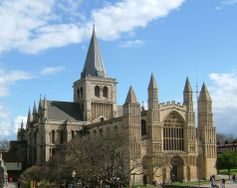 Rochester Cathedral viewed from the Castle Gardens |
|
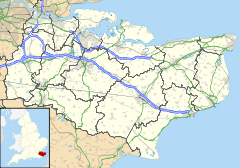 Rochester
|
|
| Population | 27,000 (2001 Census) |
|---|---|
| OS grid reference | |
| Unitary authority | Medway |
| Ceremonial county | Kent |
| Region | South East |
| Country | England |
| Sovereign state | United Kingdom |
| Post town | ROCHESTER |
| Postcode district | ME1, ME2 |
| Dialling code | 01634 |
| Police | Kent |
| Fire | Kent |
| Ambulance | South East Coast |
| EU Parliament | South East England |
| UK Parliament | Rochester & Strood |
| List of places: UK • England • Kent | |
Rochester is a town and former city in Kent, England. It is located within the unitary authority area of Medway and is at the lowest bridging point of the River Medway about 30 miles (48 km) from London. The town is known for its cathedral and castle, and for an epic siege in 1215.[1] Rochester, together with neighbouring Chatham, Gillingham, Strood and a number of outlying villages makes up the Medway unitary authority area.
Contents |
History
Toponymy
The Romano-British name for Rochester was Durobrivae. This is commonly translated as 'stronghold by the bridge' or 'stronghold by the bridges'.[2] This could have been a Belgic Settlement or oppidum, but there was no bridge in AD 43.[3] It was also known as Durobrovum and Durobrivis, which could be a Latinisation of the British word 'Dourbruf' meaning swiftstream.[4]
It is recorded as Durobrivis c.730 and Dorobrevis in 844.[2] It was pronounced as 'Robrivis. Bede copied down this name, c730, mistaking its meaning as Hrofi's fortified camp (OE Hrofes cæster). From this we get c730 Hrofæscæstre, 811 Hrofescester, 1086 Rovescester, 1610 Rochester.[2]
As the name for the city of Rochester contains the Latin word 'castra', which is present in the names of many cities that were once Roman camps (e.g. Chester Latin 'Deva'), it is assumed that Rochester was a fortified Roman town, but no evidence has been found of such fort. The Roman street pattern suggest that it was a line of shops and houses built alongside a road, and systematic fortification did not take place until after AD 175.[3]
The Latinised adjective 'Roffensis' refers to Rochester.[4]
Pre Roman
- Pre-Roman: Evidence of Neolithic settlement nearby at Kit's Coty House. Belgic remains were found in 1961 by R E Chaplin under the Roman levels. Coin moulds suggest that this was a centre of some importance.
- Celtic: Rochester was one of the two oppida of the Cantiaci tribe (the other being their capital of Durovernum Cantiacorum, modern day Canterbury). It was the western administrative centre of the Celtic kingdom.
Roman
- AD 43: The Romans arrived and called the settlement Durobrivae. On the strength of this name alone, one theory suggests that there was a 'fortified town by a bridge'. There was no bridge when the Romans arrived, and no fort has been discovered by archaeologists. Alternatively, Aulus Plautius set up a small fort, which was not needed long, as Kent was soon settled. The Roman settlement provides us with the present High Street and Northgate/Boley Hill.[3] A bridge was built. There is evidence that the Romans bridged the river at the same point as the present bridge. They constructed a substantial causeway, 14 ft (4.3 m) wide, over the marshy ground on the Strood Side of the river, from the river to the present day Angel Corner.[3]
- 190+: Systematic earthen fortifications were established.
- 225+: These were replaced by stone, which are still extant.
- 427 Romans leave Britain
Kentish Kings
- 410 – 604: Tradition states that Rochester was continuously occupied by Celts, Jutes and/or Saxons. The Jutish brothers Hengist and Horsa landed at Ebbsfleet in AD 449, and defeated the Britons at Aylesford.
- 600: King Ethelbert of Kent (560-616) made a code of about 90 laws dealing with criminal acts, which were copied in twelfth century in the Textus Roffensis.
- 604: Augustine of Canterbury sends Justus to found a cathedral at Rochester, 42 ft (13 m) high and 28 ft (8.5 m) wide. The apse is marked in the present cathedral. This was the second see after Canterbury.
- 604: The King's School is founded.
- 676: Rochester was sacked by Æthelred of Mercia.
- 730: Bede writes down the name as Hrofæscæstre.
- 842: Sacked by the Danes.
- 877: Alfred of Wessex orders the building of ships to fight the Danes. This could be the start of Medway's military shipbuilding history.
- 884: Under siege from the Danes again.
- 930: Rochester has a right to mint coins.
- 960: Wooden bridge across the Medway.[5]
All this is evidence of an important and thriving continuous civic life.
Norman
- 1077: Gundulf is consecrated bishop.
- 1080: Gundulf commences the new cathedral, on the site between the Roman wall and Watling Street, over the previous cathedral.
- 1087: Gundulf starts building the Norman castle. Its curtain wall follow Roman walls, and its keep is 113 ft (34 m) high, 70 ft (21 m) × 70 ft (21 m) in breadth.
- 1125: Textus Roffensis
- 1130: The Norman cathedral is complete.
Middle Ages
- 1215: Besieged by King John. It fell on November 30.
- 1227: Completion of Early English quire at the cathedral.
- 1264: City attacked by Simon de Montfort.
- 1343: Central tower at cathedral raised.
- 1461: The first mayor.
- 1470: The great window at the cathedral is built.
Rochester Cathedral is one of England's smaller cathedrals, yet it demonstrates all styles of Romanesque and Gothic architecture.[5]
Tudor and Stuart
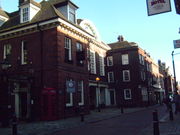
- 1504 – 1535: John Fisher, bishop. 1535 appointed cardinal and executed by Henry VIII because he refused to sanction the divorce of Catherine of Aragon. Canonised in 1935.
- 1547 – 1550: Nicholas Ridley, bishop. 1554 executed by Queen Mary for demands of faith: a Protestant martyr.
- 1559: Construction of Upnor Castle to protect Chatham Dockyard. Upnor is an estuarine water castle.
- 20 May 1660: Sir Francis Clarke entertained King Charles II on the eve of his restoration to the throne. Following this, his home in Crow Lane became known as Restoration House. It was used as the basis of Satis House in Great Expectations, by Charles Dickens.
- 11 June 1667: Dutch Raid on the Medway. In the Second Anglo-Dutch War the Dutch under de Ruijter broke through the chain at Upnor and sailed to Rochester Bridge capturing and firing the English fleet.[6] Trophies from the raid are in the Rijksmuseum, Amsterdam.
- 1687: Construction of the Guildhall, the ceiling being given by Sir Cloudesley Shovell.[5]
- December 1688: King James II spent his last night as king at a house in the High Street which became known as Abdication House.
Georgian and Victorian
- 1701: Sir Joseph Williamson's Mathematical School, a boys' grammar school, was founded.
- 1850: Thomas Aveling financed by his father in law bought a small millwrighting shop in Edwards yard, where he set up a business producing and repairing agricultural plant.[5]
- 1861: Thomas Aveling and Richard Porter move to Strood and establish Aveling & Porter, the engineering company which was to become the largest manufacturer of agricultural machines and steam rollers in the country.Of the 12,700 steam engines which they made, no fewer than 8,600 of them were steam rollers.[5][7]
20th and 21st centuries
- 1974: The municipal borough and city of Rochester merged with the borough of Chatham and part of the Strood Rural District including the Hoo Peninsula. The resulting district was the Borough of Medway. It was later renamed Rochester-upon-Medway, and the city status transferred to the entire borough.
- 1998: the council merged with Gillingham and Chatham to form the Medway unitary authority. The outgoing council neglected to appoint ceremonial "Charter Trustees" to continue to represent the historic Rochester area, causing Rochester to lose its city status - an error not even noticed by the council for four years, until 2002.[8][9][10]
Military history
Rochester has for centuries been of great strategic importance through its position near the confluence of the Thames and the Medway. Its castle was built to guard the river crossing, and the Royal Dockyard at Chatham was the key to the Royal Navy's long period of supremacy. The town, as part of Medway, is surrounded by two circles of fortresses; the inner line of forts built during the Napoleonic wars are; Fort Clarence, Fort Pitt, Fort Amherst and Fort Gillingham. The outer line of "Palmerston" forts was built during 1860s in light of the Royal Commission on the Defence of the United Kingdom report, these consisted of Fort Borstal, Fort Bridgewood, Fort Luton, and Twydall Redoubts, with 2 forts on islands in the Medway; Fort Hoo and Fort Darnet.
During the First World War the Short Brothers' aircraft company manufactured the first plane to launch a torpedo, the Short Admiralty Type 184, and during the Second World War manufactured the first four-engined bomber, the Stirling, and flying boats at its seaplane factory on the River Medway not far from Rochester Castle.
The decline in naval power and in shipbuilding in general led to the government abandoning the shipyard at Chatham in 1984, and the subsequent demise of much of the marine industry. Rochester and its neighbouring communities were hit hard by this and have experienced a painful adjustment to a post-industrial economy, with much social deprivation and unemployment resulting. On the closure of Chatham Dockyard the area saw an unprecedented surge in unemployment to 15.9%. This dropped to 3.5% in 2004.
Governance
Civic history and traditions
Rochester and its neighbours, Chatham and Gillingham, form a single large urban area known as the Medway Towns with a population of about 250,000. However Rochester has always governed land on the other side of the Medway in Strood. This was known as Strood Intra; before 1835 it was about 100 yards wide and stretched to Gun Lane. In the 1835 Municipal Corporations Act the boundaries were extended to include more of Strood and Frindsbury, and part of Chatham known as Chatham Intra. In 1974, Rochester City Council was abolished and superseded by Medway Borough Council, which also included the parishes of Cuxton, Halling and Cliffe, and the Hoo Peninsula. In 1979 the borough became Rochester-upon-Medway. The Mayor of Rochester was also Admiral of the Medway and thisdignity was transferred to the Mayor of Medway when that unitary authority was created, along with the Admiralty Court for the river which is constituted as a committee of the Council.
Like many of the mediaeval towns of England Rochester had municipal Freemen whose civic duties were abolished by the Municipal Corporations Act 1835. However, the working guild of Free Fishers and Dredgers continued and still have rights, duties and responsibilities on the Medway, between Sheerness and Hawkwood Stone. This authority is effected through their attendance at the Admiralty Court as the jury of Freemen responsible for the conservancy of the river through current legislation. The freedom is passed through 'servitude' ie apprenticeship to a working freeman. The annual ceremonial beating of the bounds on the river takes place after the Court, usually on the first Saturday of July.
Rochester had long been a city but the council (Labour) deliberately allowed the registration of its city status to lapse, in order to make a political point. Subsequently, the new council has decided to restore this centuries old city status and has written to Queen Elizabeth II to ask that this be re-conferred.
Watling Street passes through the town, and to the south the River Medway is bridged by the M2 motorway and High Speed 1.
Parishes
There were three parishes within the city of Rochester, St Margaret's, St Nicholas' and the Cathedral.[11]
Geography
The town is home to a number of important historic buildings, the most prominent of which are the Guildhall, the Corn Exchange, Restoration House, Eastgate House, Rochester Castle and Rochester Cathedral. Many of the buildings in the town centre date from the 18th century or as early as the 14th century.
Economy
Rochester Airport
Rochester City Council bought the land at Rochester Airfield in September 1933 from the landowner as the site for a municipal airport. One month later Short Brothers, who had started building aircraft in 1909 on the Isle of Sheppey, asked for permission to lease the land for test flying.
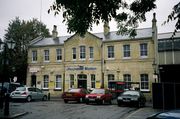
In 1934-5 Short Brothers took over the Rochester Airport site when they moved some of their personnel from the existing seaplane works. The inaugural flight into Rochester was from Gravesend, John Parker flying their Short Scion G-ACJI.
In 1979 the lease reverted to the council. After giving thorough consideration to closing the airport, GEC (then comprising Marconi and instrument makers Elliot Automation) decided to take over management of the airport. It maintained two grass runways while releasing some land for light industrial expansion.
Culture
Dickens
The town was for many years the favourite of Charles Dickens who lived nearby at Gads Hill Place, Higham, and who based many of his novels in the area. Descriptions of the town appear in Pickwick Papers , Great Expectations and lightly fictionalised as Cloisterham in The Mystery of Edwin Drood. Restoration house located on Crow Lane was the house on which Charles Dickens based Miss Havisham's (from Great Expectations) house, Satis House. This link is celebrated in Rochester's Dickens Festival each June in the Summer Dickens Festival[12] and December with the Dickensian Christmas Festival.[13] The 16th century red-brick Eastgate House once housed the town's museum. In the 1980s the museum was moved further west to the Guildhall so that Eastgate House could become the Charles Dickens Centre.
In the same decade the High Street was redecorated with Victorian-style street lights and hanging flower baskets to give it a more welcoming atmosphere.
The Dickens Centre was ultimately unprofitable and shut in November 2004. Medway Council's Cabinet agreed proposals for the restoration and development of Eastgate House as a major cultural and tourist facility, and for the project to be recognised as a key cultural regeneration project on 7 November 2006.[14]
Rochester Sweeps Festival
Since 1980 the town has seen the revival of the historic Rochester Jack-in-the-Green May Day dancing chimney sweeps tradition, which died out in the early 1900s. Whilst not unique to Rochester, (similar sweeps gatherings were held right across southern England, notably in Bristol, Deptford, Whitstable and Hastings), the Rochester revival was directly inspired by Dicken's description of the celebration in Sketches by Boz.
It has since grown from a small gathering of local Morris dance sides, to one of the largest in the world.
The current festival begins with the awakening of the Jack-in-the-Green ceremony,[15] atop Blue Bell Hill at sunrise on May 1.[16] and continues in Rochester High Street over the May Bank Holiday weekend.
Library
A new library was built alongside the Adult Education Centre, Eastgate. This enabled the registry office to move from Maidstone Road, Chatham to the Corn Exchange in Rochester High Street (where the library was housed). As mentioned in a report presented to Medway Council's community services overview and scrutiny committee on 28 March 2006, the new library opened in late summer (2006).[17]
Media
Rochester is the setting of the controversial 1965 Peter Watkins television film The War Game, which depicts the town's destruction by a nuclear missile.[18] The opening sequence was shot in Chatham Town Hall, but the credits particularly thank the people of Dover, Gravesend and Tonbridge.
The 1959 James Bond Goldfinger (novel) describes Bond driving along the A2 through the Medway Towns from Strood to Chatham. Of interest is the mention of "inevitable traffic jams" on the Strood side of Rochester Bridge, the novel being written some years prior to the construction of the M2 motorway Medway bypass.
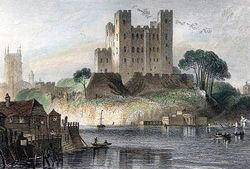
The model and actress Kelly Brook went to Delce Junior School, Rochester, and later Thomas Aveling School (Formerly Warren Wood Girls School) Rochester
Billy Childish, artist, author, poet, photographer and co-founder of the art movement Stuckism lives nearby in Chatham and there is also a growing music scene of Medway groups, including Kid Harpoon[19] and Lupen Crook.[20]
The University for the Creative Arts, formerly the Kent Institute of Art & Design, can be found on the Rochester-Chatham border.
Newspapers
Local newspapers for Rochester include The News published by Kent Regional News and Media; and the Medway Messenger, published by the KM Group. The town also has free newspapers in the Medway Extra (KM Group) and yourmedway (KOS Media).
Radio
The local radio station for Rochester is KMFM Medway, owned by the KM Group. The area can also receive the county wide stations BBC Radio Kent, Heart and Gold, as well as many radio stations in Essex and Greater London.
Sport
The main sports played in the town are cricket with many teams playing in the Kent Cricket League, and football, with teams competing in a Saturday league and a Sunday league. Rochester F.C. was an old football club but has been defunct for many decades. Nearby Gillingham F.C. are seen to represent the Medway area in football. Rugby is also played, Medway RFC play their matches at Priestfields. Local team Old Williamsonians also play nearby, and are connected to Sir Joseph Williamson's Mathematical School.
Speedway was staged a track in City Way This opened in 1932. Proposals for a revival in the early 1970s did not materialise and the Rochester Bombers became the Romford Bombers.
See also
- Medway
- Gillingham
- Chatham
- Strood
- Medway Little Theatre
- Rochester (HM Prison)
References
- ↑ English Heritage Rochester Castle
- ↑ 2.0 2.1 2.2 The Place names of Kent. Judith Glover.1976 Batsford. 1982 Meresborough Books. ISBN 0905270 614
- ↑ 3.0 3.1 3.2 3.3 Rochester, The evolution of the City. Ronald Marsh. 1974 p&p Medway Borough Council.
- ↑ 4.0 4.1 Kelly's Directory of Rochester 1951.
- ↑ 5.0 5.1 5.2 5.3 5.4 Rochester, The past 2000 years, Published Privately City of Rochester Society 1999.
- ↑ *The Dutch Raid, published by the City of Rochester Society 1998.
- ↑ *Discovering Traction Engines, - Harold Bonnett - Shire Publications (1975) - ISBN 0-85263-318-1
- ↑ http://www.medway.gov.uk/orc20030304r-5.pdf?file=10698
- ↑ BBC News 2002/05/02
- ↑ BBC News 2008/07/17
- ↑ C Humpherey-Smith, The Phillimore Atlas and Index of Parish Registers
- ↑ http://www.historic-uk.com/DestinationsUK/Rochester.htm
- ↑ http://www.historic-uk.com/DestinationsUK/Rochester.htm
- ↑ http://www.medway.gov.uk/cabinetdecisions-past_issues.asp?ID=1127
- ↑ http://www.bbc.co.uk/dna/h2g2/pda/A707861
- ↑ *City of Rochester upon Medway Visitors Guide 1996.
- ↑ http://www.medway.gov.uk/ocs20060328r-11.pdf
- ↑ War Game, The
- ↑ http://www.kidharpoon.com/
- ↑ http://www.lupencrook.co.uk/
External links
- Medway Council Official Site
- Archive Images
- The Medway Portal
- Bob Marshall-Andrews QC MP
- Rochester Airport and British Aviation
- Photographs of the Rochester Sweeps Festival
- Google video of Morris Dancers at Sweeps Festival Rochester 1997
- Rochester Taxi
- Medway Rugby Football Club
- Old Williamsonians RFC
|
||||||||
|
||||||||||||||||||||